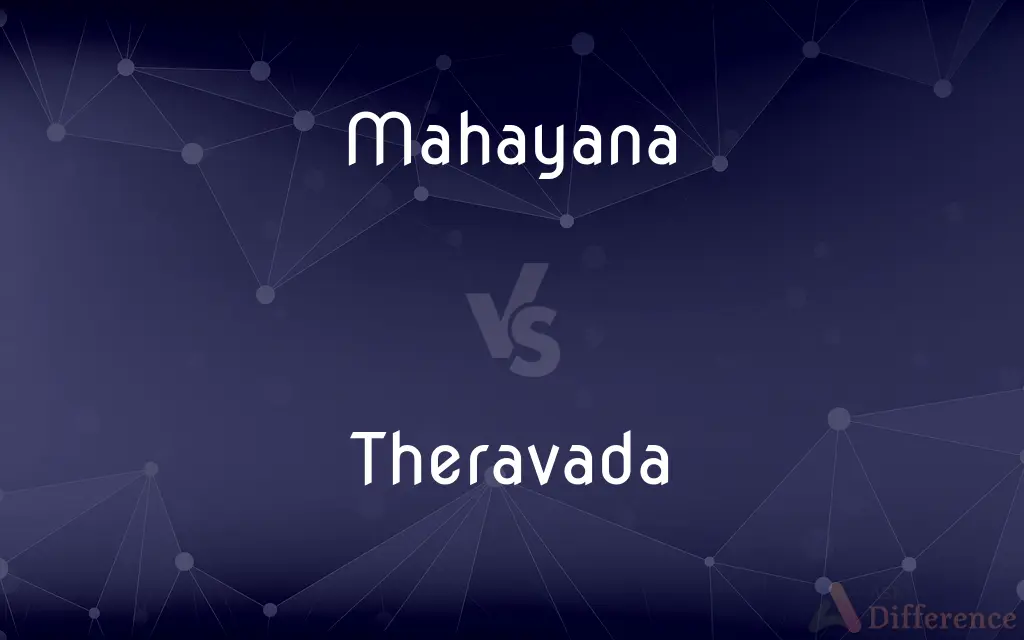Mahayana vs. Theravada — What's the Difference?
By Tayyaba Rehman — Updated on September 25, 2023
Mahayana emphasizes the Bodhisattva path and universal salvation; Theravada focuses on individual enlightenment and follows the Pali Canon.

Difference Between Mahayana and Theravada
Table of Contents
ADVERTISEMENT
Key Differences
Mahayana and Theravada are two major branches of Buddhism with distinct philosophical and cultural attributes. Mahayana, often termed the "Greater Vehicle," embraces the idea of universally accessible enlightenment. It emphasizes the altruistic path of the Bodhisattva, a being who delays their own enlightenment to assist others in achieving it. This branch believes in the potential of all beings to attain Buddhahood.
Theravada, known as the "Teaching of the Elders," is often seen as more conservative. It underscores individual enlightenment and follows the teachings present in the Pali Canon, the oldest complete Buddhist canon. Monasticism holds significant importance in Theravada, with monks playing key roles in spiritual teachings and community leadership.
While both branches value the teachings of the Buddha, their interpretations vary. Mahayana scriptures include a wider range of texts, not limited to the Pali Canon, offering diverse perspectives on Buddha's teachings. Theravada, however, upholds the Pali Canon as the authoritative record of Buddha's original teachings.
Geographically, Theravada predominantly flourishes in countries like Sri Lanka, Thailand, and Cambodia. In contrast, Mahayana has a stronger presence in regions like China, Japan, and Tibet. Despite their differences, both branches share a mutual goal: the alleviation of suffering and the attainment of enlightenment.
Comparison Chart
Philosophical Focus
Emphasizes the Bodhisattva path and universal salvation
Concentrates on individual enlightenment
ADVERTISEMENT
Key Texts
Broad range of scriptures
Primarily follows the Pali Canon
Geographical Dominance
Found in China, Japan, and Tibet
Predominant in Sri Lanka, Thailand, and Cambodia
Path to Enlightenment
Emphasizes collective salvation
Focuses on monastic life and individual liberation
Main Objective
Achieving Buddhahood for the benefit of all beings
Personal enlightenment and Nibbana (Nirvana)
Compare with Definitions
Mahayana
Has diverse scriptures beyond the Pali Canon.
The Lotus Sutra is a significant text in Mahayana Buddhism.
Theravada
Known as the "Teaching of the Elders."
Theravada is considered one of the most ancient forms of Buddhism.
Mahayana
A Buddhist branch emphasizing the Bodhisattva path.
Mahayana Buddhism teaches the importance of helping others reach enlightenment.
Theravada
Centers around the teachings of the historical Buddha.
Theravada practices are closely aligned with the original teachings of Siddhartha Gautama.
Mahayana
Believes in multiple Buddhas and Bodhisattvas.
Avalokiteshvara is a renowned Bodhisattva in Mahayana traditions.
Theravada
Has a strong monastic tradition.
Monks in Theravada traditions play vital roles in spiritual teachings.
Mahayana
Known as the "Greater Vehicle" in Buddhism.
Many Mahayana traditions believe in the potential of all beings to achieve Buddhahood.
Theravada
A Buddhist branch focusing on individual enlightenment.
Theravada Buddhism emphasizes the teachings found in the Pali Canon.
Mahayana
Prominent in East and Central Asia.
Zen Buddhism, a form of Mahayana, is particularly popular in Japan.
Theravada
Dominant in South and Southeast Asia.
Theravada Buddhism is the main religious tradition in Sri Lanka.
Mahayana
Mahāyāna (; "Great Vehicle") is a term for a broad group of Buddhist traditions, texts, philosophies, and practices. Mahāyāna Buddhism developed in India (c.
Theravada
Theravāda (; Pāli, lit. "School of the Elders") is the most commonly accepted name of Buddhism's oldest existing school.
Mahayana
One of the major schools of Buddhism, traditionally active in much of Nepal, Tibet, and East Asia and emphasizing compassion and the possibility of universal salvation.
Theravada
A conservative branch of Buddhism that adheres to Pali scriptures and the nontheistic ideal of self-purification to nirvana and is dominant in Sri Lanka, Burma, Thailand, Laos, and Cambodia.
Mahayana
A major school of Buddhism teaching social concern and universal salvation, found in China; Japan; Tibet; Nepal; Korea; and Mongolia.
Theravada
One of two great schools of Buddhist doctrine emphasizing personal salvation through your own efforts; a conservative form of Buddhism that adheres to Pali scriptures and the nontheistic ideal of self purification to Nirvana; the dominant religion of Sri Lanka (Ceylon) and Myanmar (Burma) and Thailand and Laos and Cambodia
Mahayana
One of two great schools of Buddhist doctrine emphasizing a common search for universal salvation esp through faith alone; chiefly in China; Tibet; Japan.
Mahayana
A major school of Buddhism teaching social concern and universal salvation; China; Japan; Tibet; Nepal; Korea; Mongolia
Mahayana
One of two great schools of Buddhist doctrine emphasizing a common search for universal salvation especially through faith alone; the dominant religion of China and Tibet and Japan
Common Curiosities
What is the Pali Canon in Theravada Buddhism?
The Pali Canon is the oldest complete Buddhist canon, containing the Theravada tradition's foundational texts.
What is the main goal of Mahayana Buddhism?
Mahayana aims for universal salvation and the enlightenment of all beings.
Where is Mahayana Buddhism predominantly practiced?
Mahayana is mainly practiced in regions like China, Japan, and Tibet.
Are there any similarities between Mahayana and Theravada?
Both branches share core teachings of the Buddha and aim to alleviate suffering.
Do Mahayana Buddhists believe in multiple Buddhas?
Yes, Mahayana traditions acknowledge the existence of many Buddhas and Bodhisattvas.
Is the Bodhisattva concept exclusive to Mahayana?
While emphasized in Mahayana, the concept exists in other traditions but may differ in interpretation.
Is Theravada Buddhism older than Mahayana?
Yes, Theravada is often regarded as the oldest form of Buddhism.
What role do monks play in Theravada Buddhism?
Monks in Theravada are central to spiritual teachings and community leadership.
How do Mahayana Buddhists view the Bodhisattva?
In Mahayana, a Bodhisattva is one who delays personal enlightenment to help others achieve it.
How do the scriptures differ between Mahayana and Theravada?
Mahayana has a broader range of texts, while Theravada primarily follows the Pali Canon.
Share Your Discovery

Previous Comparison
Diode vs. Transistor
Next Comparison
Engineer vs. ArchitectAuthor Spotlight
Written by
Tayyaba RehmanTayyaba Rehman is a distinguished writer, currently serving as a primary contributor to askdifference.com. As a researcher in semantics and etymology, Tayyaba's passion for the complexity of languages and their distinctions has found a perfect home on the platform. Tayyaba delves into the intricacies of language, distinguishing between commonly confused words and phrases, thereby providing clarity for readers worldwide.














































